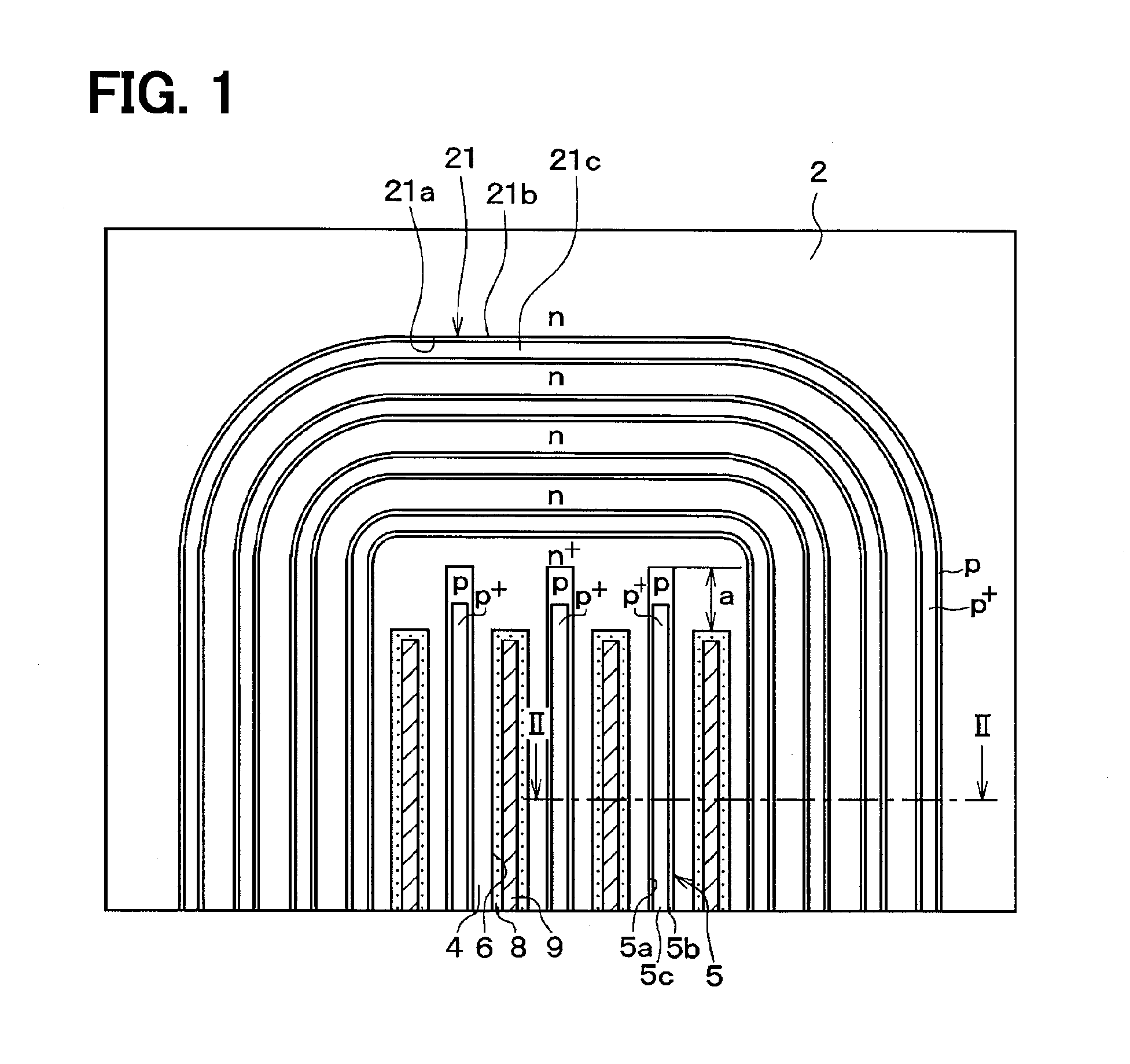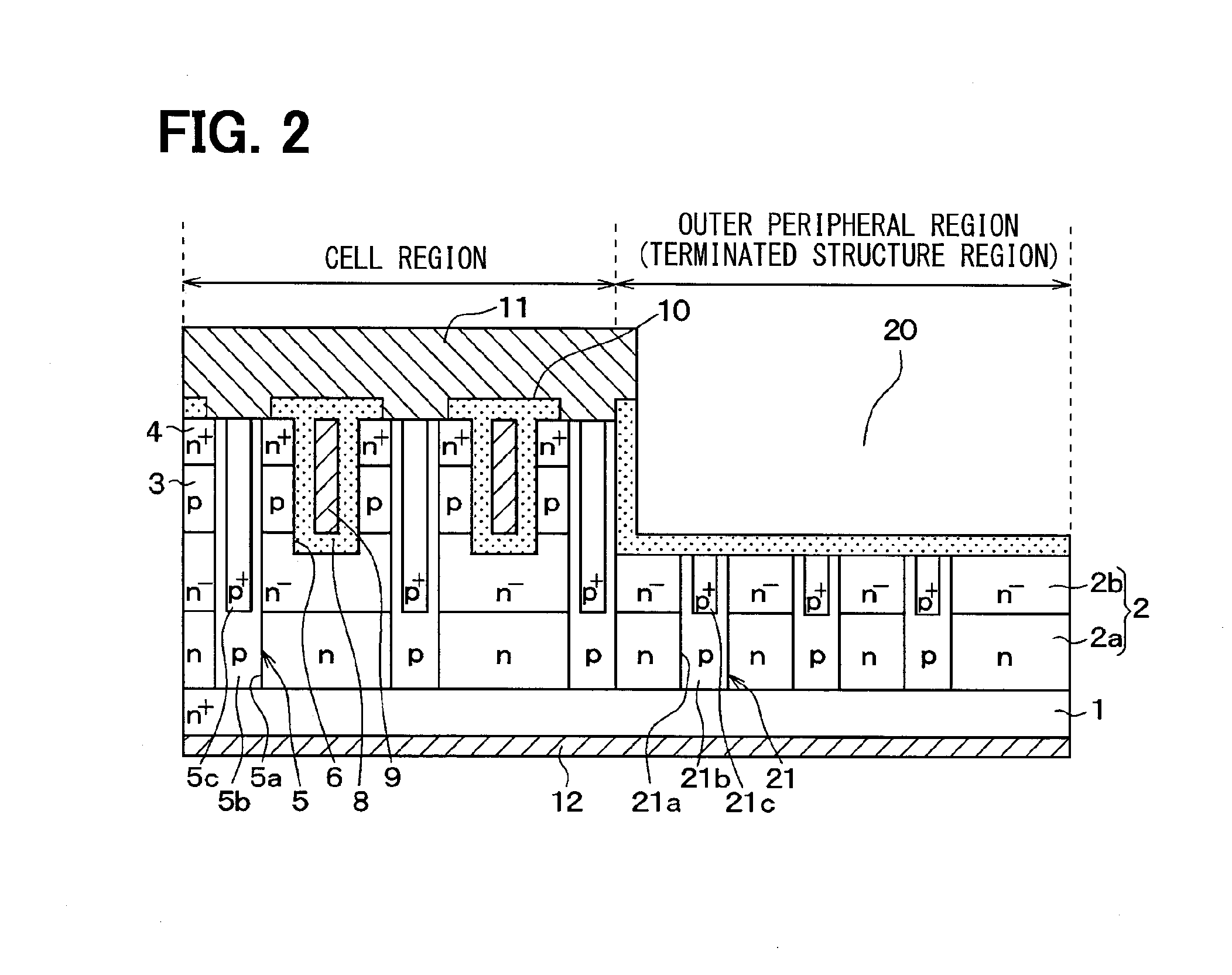Silicon carbide semiconductor device and method for producing the same
a technology of silicon carbide and semiconductor devices, applied in semiconductor devices, diodes, electrical devices, etc., can solve problems such as the breakage of gate insulation films, and achieve the effect of simplifying the production process
- Summary
- Abstract
- Description
- Claims
- Application Information
AI Technical Summary
Benefits of technology
Problems solved by technology
Method used
Image
Examples
first embodiment
[0038]A first embodiment of the present disclosure will be described. Hereinafter, an SiC semiconductor device formed with an inversion type MOSFET, as an example of a semiconductor switching element with a trench gate structure, will be described.
[0039]An SiC semiconductor device shown in FIG. 1 has a structure that includes a cell region in which a semiconductor element is formed, and an outer peripheral region (terminated structure region) in which an outer peripheral withstand voltage structure surrounding the cell region is provided.
[0040]In the present embodiment, as the semiconductor element, the MOSFET with the inversion type trench gate structure is provided.
[0041]As shown in FIG. 2, the SiC semiconductor device is formed using a semiconductor substrate in which an n− type drift layer 2, a p type base region 3, and an n+ type source region 4, which are made of SiC, are subsequently epitaxially grown on a main surface of an n+ type substrate 1 made of SiC.
[0042]The n+ type s...
second embodiment
[0077]A second embodiment of the present disclosure will be described. The present embodiment is different from the first embodiment in regard to the depth of the trench 6 and the recessed portion 20. The others are similar to those of the first embodiment. Therefore, only a part different from the first embodiment will be described.
[0078]In the present embodiment, as shown in FIG. 4, the trench 6 and the recessed portion 20 are different in depth. In particular, the recessed portion 20 is deeper than the trench 6. In the case where the trench 6 and the recessed portion 20 are set to have different depths, it is possible to design the withstand voltage for each of the trench 6 and the recessed portion 20. It is possible to suitably adjust the withstand voltage such that breakdown is generated in the outer peripheral region, for example.
[0079]In the production process of the SiC semiconductor device having such a structure, the step of forming the trench 6 and the step of forming the...
third embodiment
[0080]A third embodiment of the present disclosure will be described. In the present embodiment, a structure of the p type impurity embedded layer 21 is modified from that of the first embodiment, and the others are the similar to those of the first embodiment. Therefore, only a part different from the first embodiment will be described.
[0081]In the present embodiment, as shown in FIG. 5, the depth of the trenches 21a and the p type impurity embedded layers 21 is varied. The depth of the trenches 21a and the p type impurity embedded layers 21 is gradually reduced as a function of distance from the cell region in an outward direction. In this way, the depth of the p type impurity embedded layers 21 is gradually varied. Therefore, it is possible to configure the p type impurity embedded layers 21 with the shape according to an equipotential line distribution in the outer peripheral region, and thus it is possible to reduce the region necessary for a termination structure. For this rea...
PUM
 Login to View More
Login to View More Abstract
Description
Claims
Application Information
 Login to View More
Login to View More - R&D
- Intellectual Property
- Life Sciences
- Materials
- Tech Scout
- Unparalleled Data Quality
- Higher Quality Content
- 60% Fewer Hallucinations
Browse by: Latest US Patents, China's latest patents, Technical Efficacy Thesaurus, Application Domain, Technology Topic, Popular Technical Reports.
© 2025 PatSnap. All rights reserved.Legal|Privacy policy|Modern Slavery Act Transparency Statement|Sitemap|About US| Contact US: help@patsnap.com



